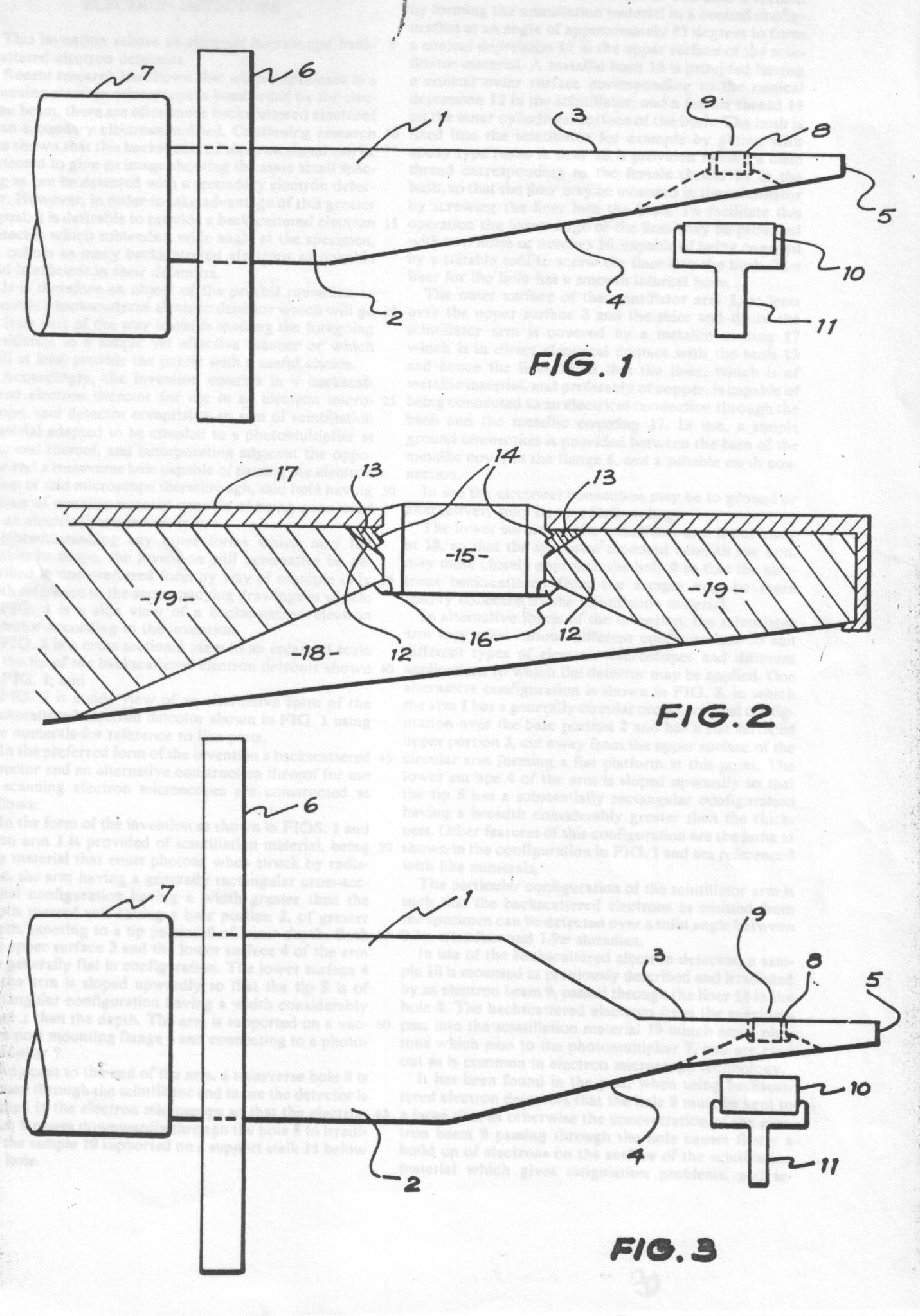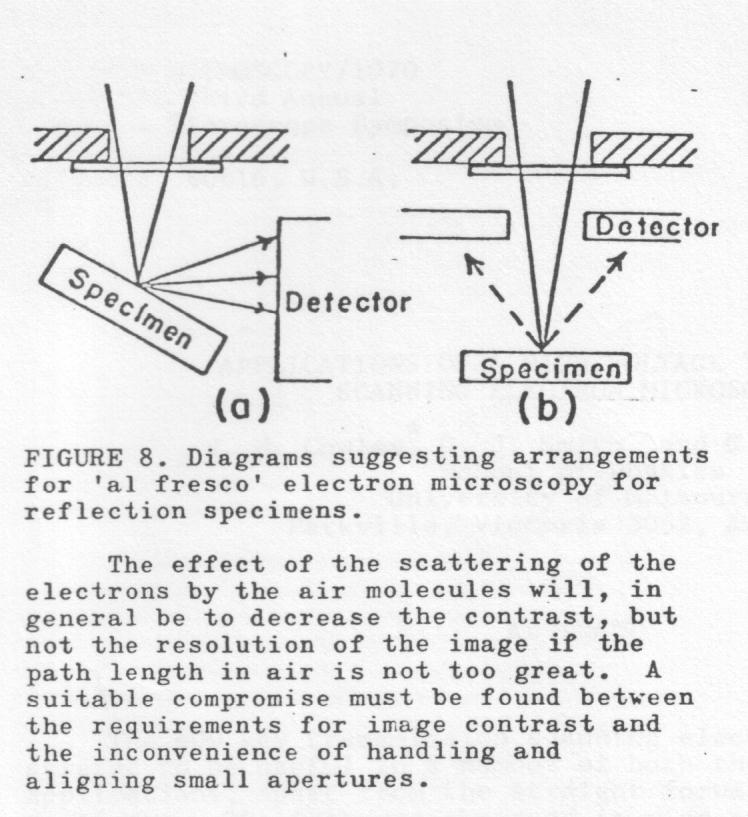

Robinson's detector is a backscattered electron (BSE) detector used for imaging in scanning electron microscopy (SEM). A reliable definition of this detector is needed for scientists but may not be easily found or established. Perhaps, the most reliable definition may be derived from a patent US4217495 issued to Vivian N. E. Robinson on August 12 1980 (filed in 1979). Thereby, it is claimed a BSE detector comprising an arm of scintillation material adapted to be coupled to a photomultiplier at one end thereof and incorporating adjacent the opposite end a transverse hole capable of passing the electron beam of the microscope therethrough, said hole having a liner of metallic material capable of being connected to an electrical connection in use. The said liner is readily removable from said hole, or fixed or glued with epoxy resin via a female bush. The arm of the detector is provided with a metallic covering over at least its upper surface with an electrical connection to the liner, which may be earthed. The scintillation material is cut away in a cone-like configuration beneath said liner. The bore through said liner is less than 15 mm or less than 10 mm in diameter. The scintillation material subtends a solid angle at the specimen of between 0.8p steradian and 1.8p steradian.
The above description is a a condensed form of the claims and the reader should refer to the expired patent itself above for other details. The commercialization of the product may have been a success story and by no means the analysis below aims at detracting from this achievement. The only problem arises from the name of the said detector, because it has created much confusion and misunderstanding even from its very early publication in 1973. The confusion probably arises from mixing commercial claims with scientific innovation. One problem arises when the use of scintillating materials in BSE detection (frequently used by other workers) is often wrongly attributed (or thought to be due) to Robinson. Another problem concerns the originality of this detector. Yet a third set of problems arises from the technical claims made by Robinson in his publications preceding or following the filing/issuing of that patent.
Originally, Robinson (1973) claimed that a 2p collection angle of the BSE gives the same resolution as the secondary (SE) electron detector. This claim and others were strongly criticized in the electron microscopy community throughout the seventies and beyond for as long as Robinson persisted with his claim. One sample of discussion is found, for example, in one publication by Robinson (1975), from which we quote the queries by one reviewer, namely: " Reviewer III: You credit the unbiased scintillator detector to Schur et al. 1974 (text ref. 17). An earlier reference is T.E. Everhart, O.C. Wells and C.W. Oatley, J. Electronics Contr. 2, 97-111(1959), where it is stated that such a detector can "...subtend an angle of 90 degrees at the surface of the object and thus... collect a far higher proportion of the electrons than heretofore." H. Ahmed, Sci. Prog. Oxf., 57, 259-271 (1969); H. Ahmed, and D.C. George, Micron 3, 69-77(1972), used a similar arrangement for studying hot cathodes. Incidentally, the use of a scintillator with a hole in it for the beam to pass through was also investigated at that time (O.C. Wells PhD. Diss., Cambridge Univ., 1957), when it was concluded that it would not show the topography of a sloping metal specimen. The work of DeNee et al. (mentioned in previous question) is, I believe, very important in as much as it seems to show that it is the variation in Z, and not the topography, which is shown in the case of a stained biological specimen. ...... "
Cowley et al. (1970) had proposed the same detection configuration for "alfresco" microscopy three or four years earlier as can be seen below:

In later publications, Robinson abandoned the 2p angle and used the "wide" angle collection of BSE instead, as was actually the practice of his detector. Danilatos also experimented extensively with the Robinson detector starting in 1978. Danilatos found that although the detector subtended a wide angle, the contrast at the image did not correspond to a symmetrically collected wide angle BSE signal, as it showed both Z-contrast and directional topographic contrast . The topographic contrast was mainly due to the loss of photons (hence of signal) from the opposite side of the light guide to the photomultiplier. Furthermore, when the specimen was placed closest to the detector, the signal intensity diminished and became problematic due to the metal liner in the hole. By eliminating the metal liner, the signal was mainly detected inside the hole of the scintillator. However, this detector was not a "wide" angle detector any more, according to the prior claims by Robinson. It was a low takeoff angle inside the cylindrical hole having a generally large diameter. Danilatos then established that by not aluminizing the top of the detector or gluing a metallic covering over the upper surface (as opposed to Robinson), a good image was still possible to obtain even if the inside surface of the hole was blocked with aluminium foil, i.e. when the specimen was close (or abutting) to the hole of the detector. This was possible by the BSE being multiple-backscattered (MBSE) in the very thin space between the pole piece and the top of the detector. Furthermore, by partially blocking the lower surface of the detector on the side of the photomultiplier, it was possible to eliminate the topographic contrast and collect a predominantly Z-contrast image. In addition, Danilatos found that it was much better to use clear plastic (like perspex) material coated with a thin layer of plastic scintillating material instead of manufacturing the entire bulk of the detector from the expensive scintillating material. A small piece of scintillating material was dissolved in toluene and the solution has lasted for decades in the making of various shapes of detectors. Not only are they more economical, these detectors are also far superior in performance according to Hatzakis (1970) and Danilatos (1985). As a result of these tests and trials, Danilatos developed his own strategy and geometries for BSE imaging in the ESEM.
The ECM, a companion to the Robinson detector, is presented separately.
Allowing only the brief points above, it is clear why the "Robinson" detector must be strictly defined and understood for what it is, otherwise it may create confusion, misunderstandings and mis-attributions in the minds of workers not familiar with the literature and the history of BSE imaging and developments. It is hoped that bringing to the surface a definition of this detector by its own inventor clears the way. There would be no such problem if the detector had some other brand name so that the commercial endeavor could be easily separated out of the science and original concepts generated by different workers. Therefore, the BSE detectors designed and operated for optimum signal detection later by Danilatos constitute a novel BSE system in their own right . Should any of these or other shapes and methods come under the brand name of an eponymous detector, that would constitute a violation of science ethics and create further confusion in science by implied mis-attribution.
In this context, it is noteworthy that Fig. 3 of patent US5198675 shows a striking and practically identical design as the Danilatos detector shown by Fig. 9 . One then wonders about the value of patents in defining innovation from a purely scientific point of view, as opposed to commercial proprietary interests. At least in the latter case, the "inventor" has not called this industrial product after his name (it is hoped). Any well meaning scientist will now appreciate the clarification attempted herewith as far as the "Robinson" detector is concerned.
Robinson VNE (1973). A reappraisal of the complete electron emission spectrum in scanning electron microscopy. J. Phys. D: Appl. Phys. 6, (L105-L106).
Robinson VNE (1975). Backscattered electron imaging. Scanning Electron Microscopy/Part I, IIT Research Institute, Chicago, Illinois USA, 51-60.
Cowley JM, Smith DJ and Sussex GA (1970). Application of a high-voltage transmission scanning electron microscope. Scanning Electron Microscopy, IIT Research Institute, Chicago, Illinois, USA, 9-16.
Hatzakis M (1970). A new method of forming scintillators for electron collectors. Rev. Sci. Instrum. 41, 128.
Danilatos, G.D. (1985) Design and construction of an atmospheric or environmental SEM (part 3) . Scanning 7:26-42.